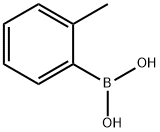Uses
2-Methylbenzeneboronic acid is a reagent used for Pd-catalyzed arylation using Suzuki-Miyaura cross-coupling in water, Ruthenium catalyzed direct arylation reactions, Ligand-free copper-catalyzed coupling reactions, Rhodium-catalyzed asymmetric 1,4-addition reactions. Reagent used in Preparation of chiral monophosphorus ligands in asymmetric Suzuki-Miyaura coupling reaction, Human farnesyl pyrophosphate synthase inhibitors as antitumor agents for multiple myeloma cells
Synthesis
Triphenylphosphene (0.131 g, 0.5 mmol, 20 mol %), p-iodoanisol (0.585 g, 2.5 mmol), and triethylamine (1.78 mL, 12.5 mmol) were added to a 50 mL round-bottomed flask equipped with a sidearm, condenser, and stir bar. This solution was then degassed by alternating vacuum and argon three times. Palladium dichloride (0.023 g, 0.13 mmol, 5 mol %) was then added under positive argon pressure. After stirring at room temperature for 15 min, diisopropylaminoborane (5 mL, 1 M solution in THF, 5 mmol) was added and the reaction mixture was degassed again by alternating vacuum and argon three times. The reaction solution was then heated to reflux. After 12 h of reflux the reaction was cooled to 0 °C and 6 mL of methanol was added through the condenser slowly (Caution: exothermic reaction with evolution of hydrogen). After 15 min of stirring all the solvent was removed under reduced pressure to yield a black solid. This solid was dissolved with sodium hydroxide (3 M, 8 mL) and subsequently washed with hexanes (3×10 mL). The aqueous layer was then cooled to 0 °C (ice bath) and acidified to pH ≤1 with concentrated HCl, with the boronic acid usually precipitating out as a white solid. The aqueous fraction was then extracted with diethyl ether (3×10 mL). The organic fractions were combined, dried with magnesium sulfate and filtered. The solvent was then removed under reduced pressure yielding a white solid named 2-Tolylboronic acid.
